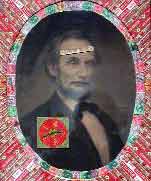 Nothing like a big dose of the art of the self-taughts to get the juices flowing. Felipe Jesus Consalvos‘s cigar paper collage wonderland is up at Fleisher Ollman Gallery and it’s a must see.
Nothing like a big dose of the art of the self-taughts to get the juices flowing. Felipe Jesus Consalvos‘s cigar paper collage wonderland is up at Fleisher Ollman Gallery and it’s a must see.
I had sampled the artist’s two-D collages made from cigar bands and wrappers over the summer and thought they were a wow of organization, symmetry and playfulness.
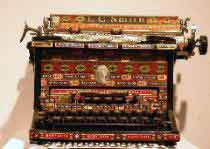
But I had no idea that in addition to making 2-D designs, the Cuban American cigar factory worker whose ouervre dates from 1920-1950 covered what looks like every stick of furniture and every object in his possession with his cigar-band, tattoo-like designs.
And in fact, the gallery has around 100 works in the show and the majority are objects.
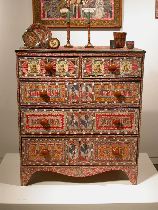
In addition to covering a host of musical instruments (guitars, flutes, banjos, tambourines), the artist, who sometimes worked with his son, Jose Felipe, adorned the following: lamps, dressers, plates, chairs, a typewriter, several telephones, a cane, binoculars, a 78 rpm record, ping pong paddles, a stool, trays, a model ship and other real world objects. The aesthetic is suffocatingly pretty and masculine.
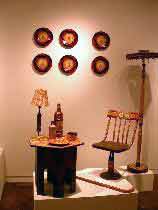
The artist liked to mock the American presidents and George Washington and Abe Lincoln appear throughout, their heads collaged on improbable bodies or — in the case of Lincoln — his lips enhanced with what looks like red lipstick (top image).
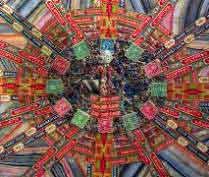
Felipe Jose, known to his family as Uncle Lipe was born in 1981 outside Havana. He emigrated to Miami in the 1920s and lived in New York and Philadelphia and worked in cigar factories both in Cuba and in the U.S. His son, Jose was born around 1912.
The Consalvoses were self-described healers and practiced a Cubo-Catholicism that included shamanistic practices and medicine making.
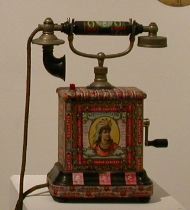
Some time in the 1980s a trove of 650 works by Consalvos was discovered in Philadelphia. It’s never been shown before this.
The gallery notes state that it’s unclear which works should be attributed to Felipe and which to Jose and consequently the work is spoken of as a single entity made by Felipe. Felipe died in Philadelphia some time before 1968.
By all means stop in for a look. Not only is the Consalvos aesthetic — handsome, symmetrical designs in Americana-like colors and motifs — great but the gallery has put out a generous spread of work and while the individual pieces are amazing, the cumulative affect is what’s got impact.
Mystical nature at More
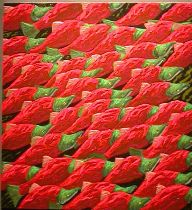 Eugene Baguskas‘s sheer love of the wilder side of the woods — its trees and waterfalls, its bears, flying birds and leaping fish — is contagious. One look at the glorious color and adoring motifs of Baguskas’s flora and fauna now on view at More and you’ll be out buying a fly fishing rod and heading to Montana (or to the video store to rent that Robert Redford/Brad Pitt fishing movie, “A River Runs Through It”).
Eugene Baguskas‘s sheer love of the wilder side of the woods — its trees and waterfalls, its bears, flying birds and leaping fish — is contagious. One look at the glorious color and adoring motifs of Baguskas’s flora and fauna now on view at More and you’ll be out buying a fly fishing rod and heading to Montana (or to the video store to rent that Robert Redford/Brad Pitt fishing movie, “A River Runs Through It”).
Baguskas transcends the literal by virtue of his over the top imagery which can only be seen as the best of all possible outdoor kingdoms.
This picture, for example, of a seemingly endless world of red salmon leaping upstream, is so lush and so optimistic and so, well, pop-Andy Warhol in a way that it made me laugh and want to hug it.
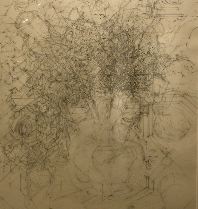
And in More’s front room, Michael Rossman, magician with a pencil, arranges his skittery lines into hallucinations that imply the real world of architecture, furniture, landscape but also the interior life of the mind working to make sense of the world. In what gallery owner Charles More said were the newest pieces, Rossman has drawn weird and wonderful emanations of flowers and vases. (image is “Bouquet”). I can’t help but think of Christine Hiebert‘s skittery line works (now at Gallery Joe) when I think of Rossman’s. Both artists translate the world through a nervous energy that denotes emotion. Rossman is more forthcoming about what’s on his mind, which helps the viewer connect with it. Hiebert, whose work I like, has let go of imagery entirely and asks the viewer to jump off the cliff with her — something few are willing or able to do.









